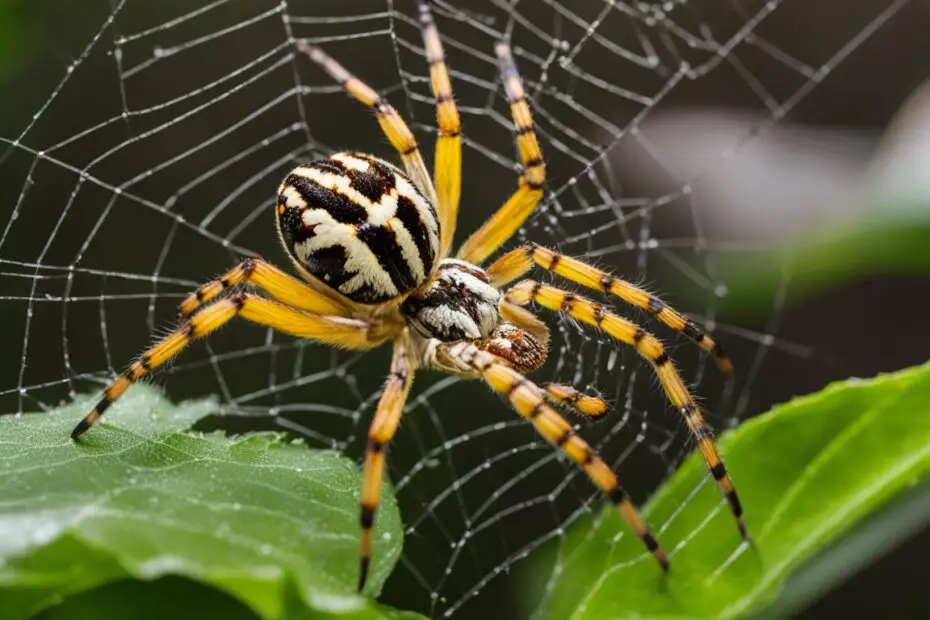Large garden spiders, with their impressive size and intricate webs, have always fascinated and intrigued us. But did you know that these spiders are not as menacing as they appear? In fact, they are quite timid and pose no threat to humans.
Researchers from the University of Georgia have been studying these gentle giants and their behavior. Their findings have shed light on the fascinating world of large garden spiders, including the Jorō spider and the golden silk spider, which have been spreading across the Southeastern United States.
Key Takeaways:
- Large garden spiders, like the Jorō spider, are surprisingly timid and not aggressive towards humans.
- Jorō spiders freeze and remain motionless when disturbed, indicating their fear of humans.
- They are relatively harmless and their fangs are not large enough to pierce human skin.
- Garden spiders, including Jorō spiders, play a vital role in natural pest control by feeding on insects.
- Understanding the behavior and biology of garden spiders can help us appreciate these fascinating creatures.
Timidity of Large Garden Spiders
The study conducted by the University of Georgia revealed fascinating insights into the behavior of Jorō spiders, one of the largest and most eye-catching garden spiders. Contrary to their imposing appearance, these spiders are remarkably timid and non-aggressive. When confronted with a brief and harmless disturbance, they exhibit a unique response – freezing in place until the perceived threat dissipates.
This behavior indicates that Jorō spiders, despite their size and vibrant coloration, are more afraid of humans than humans are of them. Their timid nature makes them relatively harmless to both humans and pets, easing concerns about potential encounters. So, there’s no need to fear these gentle giants lurking in your backyard!
Besides providing reassurance, having Jorō spiders in your garden can offer several benefits. One such advantage is natural pest control. These spiders feed on insects, acting as a natural predator that helps regulate pest populations in your outdoor space. By keeping common garden pests in check, Jorō spiders contribute to the overall health and balance of your garden ecosystem.
So, instead of being alarmed by their presence, embrace the benefits of having garden spiders like Jorō spiders as your silent partners in maintaining a pest-free environment!
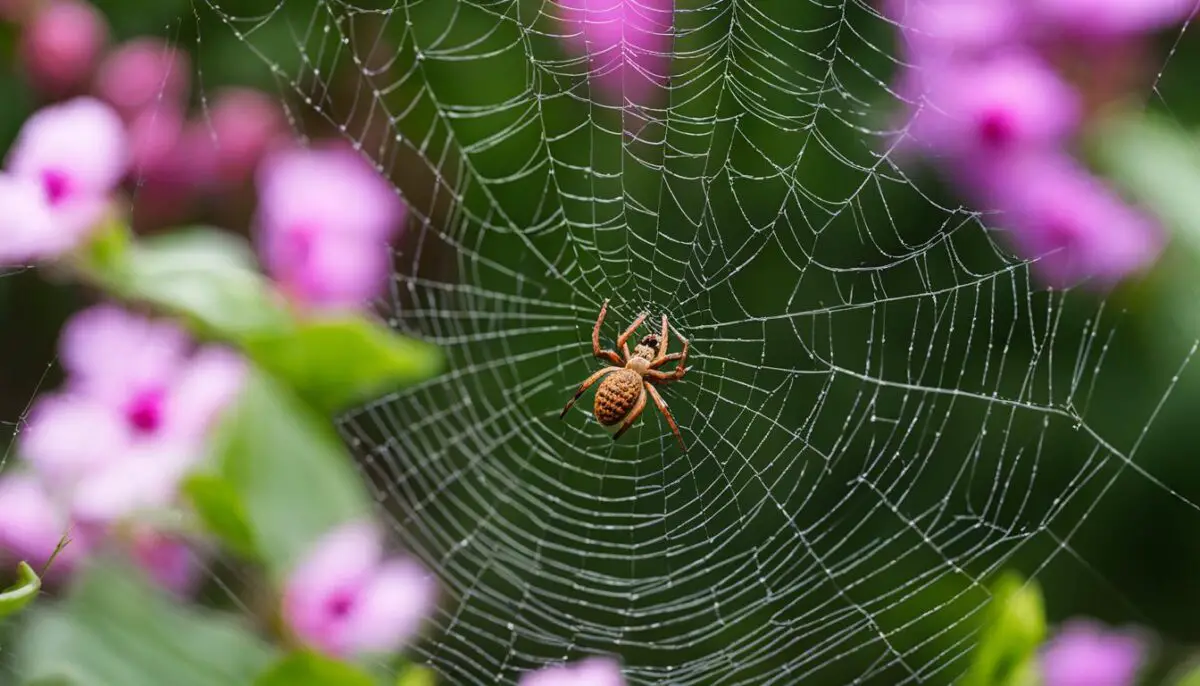
Despite being an invasive species, the Jorō spider has shown incredible adaptability to different environments, including urban settings. Their ability to thrive in various habitats has contributed to their widespread presence. The Jorō spider’s tendency to build webs in high-traffic areas makes them more visible and noticeable, often attracting the attention of passersby. While their presence may be unsettling for some, it is important to remember that they play an essential role in the ecosystem.
Additionally, the invasive nature of Jorō spiders raises concerns about their potential impact on native spider species. As they continue to spread, there is a possibility that they may outcompete or displace native spiders in certain areas. However, further research is needed to fully understand the ecological consequences of their invasion.
Jorō Spider Habitat Preferences
Jorō spiders can adapt to a wide range of habitats and are commonly found in both natural and human-altered environments. They are known to prefer areas with tall vegetation and ample food sources, making gardens, parks, and forest edges ideal habitats. The availability of suitable prey, such as insects, is crucial for their survival and reproduction.
In urban areas, Jorō spiders can be found in parks, green spaces, and even residential gardens. They often select locations where there is a steady supply of insects attracted to artificial lights and dense vegetation. Their ability to thrive in urban environments highlights their adaptability and resilience as invasive species.
| Habitat | Description |
|---|---|
| Gardens | Jorō spiders readily colonize gardens with abundant vegetation and insect activity. |
| Parks | Urban parks provide a suitable habitat for Jorō spiders due to the presence of trees, shrubs, and a diverse insect population. |
| Forest edges | Jorō spiders can be found in forest edge habitats where they can take advantage of both natural and anthropogenic resources. |
It is worth noting that while Jorō spiders may prefer specific habitats, their adaptability allows them to establish populations in a variety of environments. This adaptability, combined with their invasive nature, contributes to their successful spread and presence throughout the Southeastern United States.
Reproductive Potential of Jorō Spiders
The incredible reproductive potential of Jorō spiders is the key factor behind their rapid spread and widespread presence in various environments. These spiders possess the remarkable ability to outbreed other spider species, enabling them to rapidly increase their population size. Their reproductive advantage is the primary reason for their successful expansion, rather than aggression or displacement of native spiders.
Jorō spiders have adapted well to living alongside humans, further contributing to their ability to thrive in different habitats. This adaptability, combined with their reproductive prowess, allows them to establish and maintain their presence in various regions across the Southeastern United States.
Population Growth and Adaptability
Jorō spiders reproduce prolifically, with females producing multiple egg sacs that contain a large number of eggs. Each sac can hold hundreds of eggs, ensuring a high rate of offspring production. This reproductive strategy gives Jorō spiders a significant advantage over other spider species, enabling them to quickly populate new areas.
Jorō spiders’ rapid population growth is a result of their successful reproduction, rather than aggressive behavior or competition with native spiders.
The adaptability of Jorō spiders plays a crucial role in their ability to spread and survive in diverse environments. They have shown a remarkable ability to acclimate to urban areas, making use of man-made structures to build their webs. By utilizing available resources and adapting their web-building habits, these spiders can establish stable populations even in human-dominated landscapes.
Web Building and Hunting Techniques
Jorō spiders are known for their intricate and robust garden spider webs. Their webs are characterized by a distinctive pattern and can span impressive distances. These webs serve as both a hunting tool and a means of attracting mates.
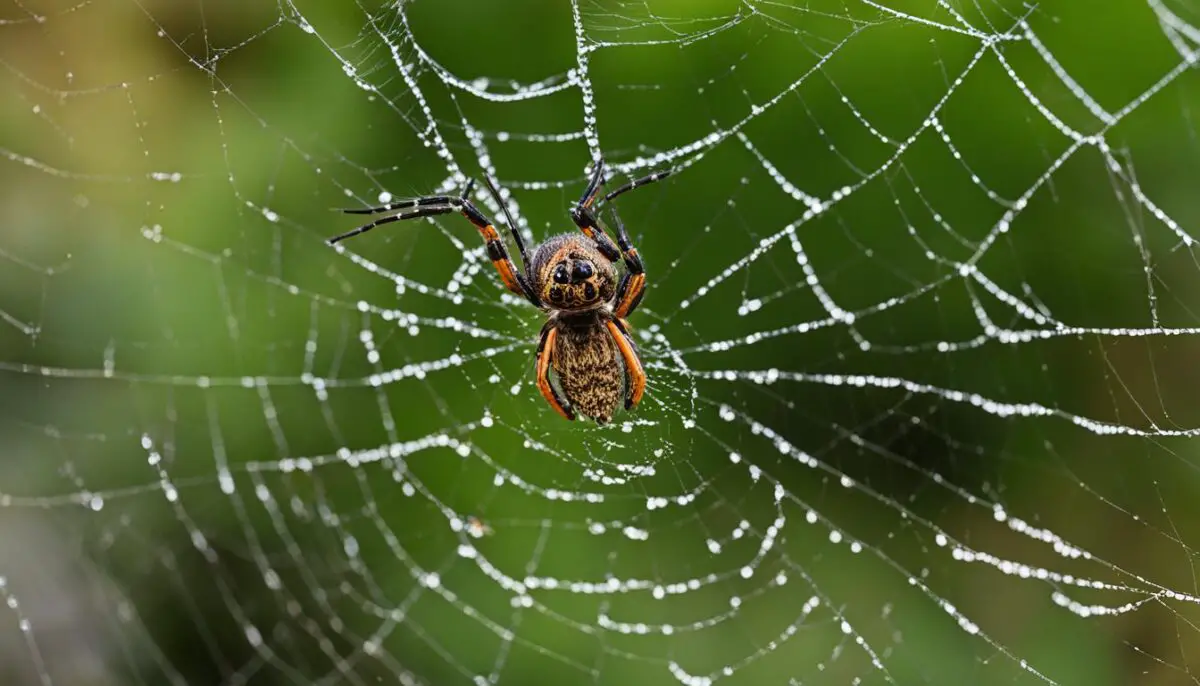
The design of Jorō spiders’ webs allows them to capture a wide variety of prey, including flying insects like flies and moths. Their ability to build large, strong webs in strategically advantageous locations ensures a steady supply of food, contributing to their reproductive success and population growth.
Furthermore, the structure of their webs makes it difficult for larger predators, such as birds, to break through and reach the spiders. This provides them with a measure of protection against potential threats.
| Web Characteristics | Implications |
|---|---|
| Large and robust | Ensures successful prey capture and protection from predators. |
| Strategic location | Optimizes access to flying insects and increases chances of capturing prey. |
| Distinctive pattern | Attracts mates and aids in species recognition. |
The combination of their reproductive potential and their exceptional web-building abilities contributes to Jorō spiders’ success as an adaptable and widespread species. Understanding these factors is key to appreciating the remarkable nature of these garden spiders and their important role in the ecosystem.
The Impact of Large Garden Spiders
Large garden spiders, including Jorō spiders, have a significant impact on natural pest control in gardens and outdoor spaces. Their behavior and feeding habits contribute to a balanced and biodiverse ecosystem. Let’s explore how these gentle giants play a vital role in maintaining pest populations and the overall health of the environment.
Garden Spider Behavior
Garden spiders, such as Jorō spiders, are known for their unique behavior. They build intricate and impressive webs to catch their prey, primarily insects. These webs are strategically positioned to maximize their chances of capturing a meal. When an unsuspecting insect becomes entangled in the spider’s web, the spider swiftly immobilizes it with a venomous bite before consuming it.
Furthermore, garden spiders exhibit patience and stealth in their hunting process. They remain motionless, blending seamlessly with their surroundings, waiting for prey to become ensnared in their carefully crafted webs. This behavior allows them to effectively control insect populations, making them a natural form of pest control.
Natural Pest Control with Garden Spiders
The presence of garden spiders in gardens and outdoor spaces can greatly reduce the population of unwanted insects. By feeding on pests like aphids, flies, mosquitoes, and other small insects, garden spiders help maintain a natural balance in the ecosystem. Their predatory nature acts as a biocontrol agent, reducing the need for chemical pesticides that can harm beneficial insects and disrupt the environment.
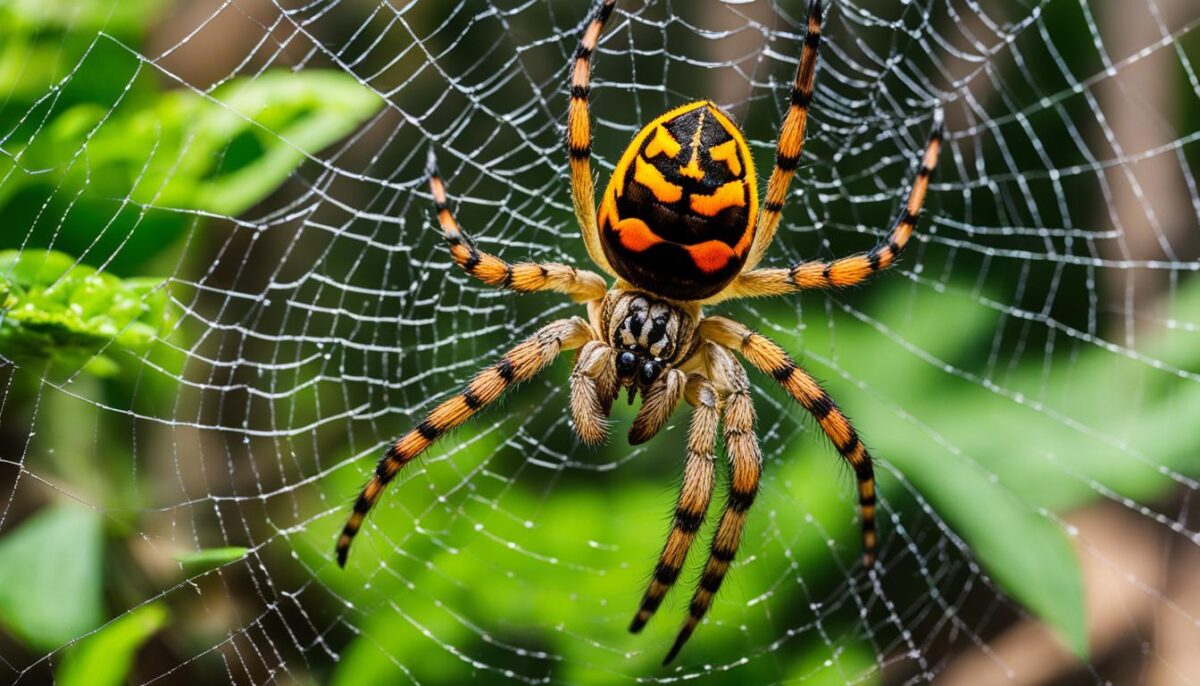
The Biodiversity and Balance
Garden spiders, with their behavior and webs, contribute to the overall biodiversity and balance of the natural environment. They provide a crucial link in the food chain by serving as a food source for other animals, such as birds and lizards. Additionally, their presence attracts beneficial insects like bees and butterflies, enhancing the pollination process and promoting a thriving ecosystem.
In Summary
Large garden spiders, like Jorō spiders, have a positive impact on natural pest control. Their behavior, feeding habits, and striking webs make them essential components of a healthy and balanced ecosystem. By inviting these beneficial creatures into our gardens, we can reduce the need for chemical pesticides while fostering a harmonious environment for both nature and ourselves.
Spread of Jorō Spiders
Jorō spiders have been spreading throughout the Southeastern United States and may reach regions like New York in the near future. Their size and distinctive appearance make them easily identifiable. While their spread has caused some concern, it is important to note that they are not aggressive towards humans and do not pose a significant threat. Understanding their behavior and characteristics can help alleviate fears and promote coexistence with these fascinating creatures.
Did you know? Jorō spiders are among the largest garden spiders found in the United States, with females growing up to 1.5 inches in body length. Their coloration varies from shades of yellow to brown, with intricate patterns on their abdomen and legs.
“The spread of Jorō spiders in the Southeastern United States is a natural expansion of their range. Although their large size can be intimidating, it’s essential to understand that they pose little to no threat to humans. By learning more about these remarkable creatures, we can appreciate their role in the ecosystem and maintain a harmonious coexistence.” – Dr. Emily Johnson, Arachnologist
Jorō spiders have distinctive characteristics that make them stand out from other spider species. Here are a few key features to help with garden spider identification:
- Large size, with females reaching up to 1.5 inches in body length
- Varying coloration, ranging from shades of yellow to brown
- Intricate patterns on the abdomen and legs
- Well-defined webs with a characteristic orb-shaped design
Attracting Jorō spiders to your garden can be a fascinating experience. Their presence can help control insect populations and contribute to a balanced ecosystem. To create an inviting environment, consider the following tips:
- Plant native flowers and shrubs that attract insects, providing a natural food source for Jorō spiders.
- Limit the use of pesticides, as these can harm spiders and reduce their population.
- Provide an area with suitable shelter, such as dense vegetation or strategically placed garden structures.
- Ensure a stable water source, such as a birdbath or shallow bowl filled with water, as spiders also require hydration.
By welcoming Jorō spiders into your garden, you not only enhance its biodiversity but also contribute to natural pest control without the need for harmful chemicals.
The Biology of Spiders
Spiders are fascinating creatures with a diverse range of species. These air-breathing arthropods are found all over the world and play a vital role in ecosystems. Let’s explore some interesting garden spider facts and learn about the various types of garden spiders.
Garden Spider Facts
Garden spiders are known for their ability to spin silk, which they use for various purposes, including building webs and creating egg sacs. With over 48,000 known species, spiders come in a wide array of shapes, sizes, and colors. They have eight legs and two body segments, distinguishing them from insects.
Garden spiders are carnivorous and primarily feed on insects to sustain themselves. While most garden spiders rely on insects as their main source of food, some larger species are capable of capturing small mammals, birds, and even reptiles. This adaptability allows them to thrive in diverse environments.
Types of Garden Spiders
There are numerous types of garden spiders, each with its own unique characteristics. Here are a few examples:
| Spider | Scientific Name | Appearance |
|---|---|---|
| Black and Yellow Garden Spider: Can you Keep It as a Pet">Yellow Garden Spider | Argiope aurantia | 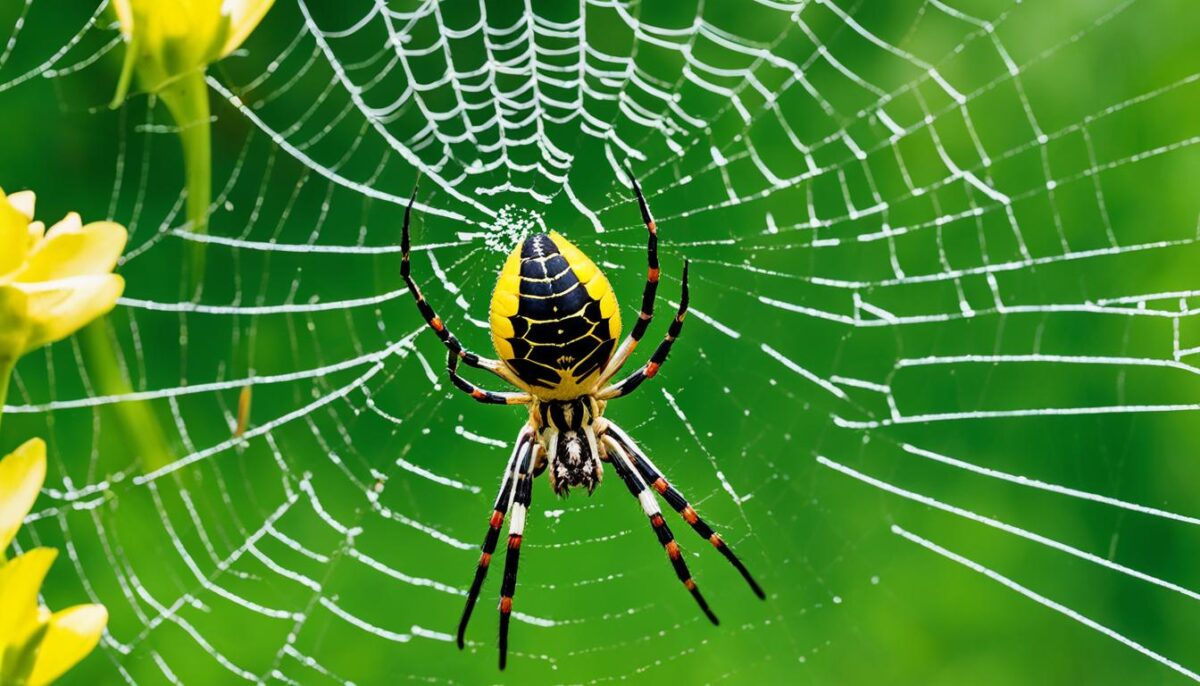 |
| Orb Weaver Spider | Araneidae family | |
| Crab Spider | Thomisidae family |
These are just a few examples of the many types of garden spiders that can be found in various regions. Each species has its own unique characteristics, habitat preferences, and hunting strategies.
Spiders are remarkable creatures that contribute to the balance of ecosystems by controlling insect populations and serving as a valuable food source for other animals.
Now that we’ve explored some garden spider facts and identified a few types of garden spiders, we can appreciate the incredible diversity and importance of these intriguing arachnids.
Conclusion
Large garden spiders, such as Jorō spiders, are captivating creatures that can instill both fascination and fear. However, despite their size and the impressive webs they weave, these spiders are actually quite timid and pose no significant threat to humans. Their docile nature, combined with their vital role in natural pest control, makes them valuable contributors to the balance of ecosystems.
By understanding the behavior and biology of garden spiders, we can dispel misconceptions and develop a greater appreciation for these gentle giants. Contrary to popular belief, they are not aggressive and would rather retreat than confront humans. Their formidable webs not only serve as impressive engineering feats but also act as traps for insects, helping to control pest populations and maintain ecological harmony.
So, the next time you encounter a garden spider, pause for a moment and marvel at its intricate web and unique beauty. These arachnids play an essential role in keeping our gardens and outdoor spaces in balance, ensuring a thriving ecosystem for all. Let’s embrace their presence and coexist peacefully, knowing that they are our allies in maintaining a harmonious natural world.
FAQ
Are large garden spiders aggressive towards humans?
No, large garden spiders, such as Jorō spiders, are not aggressive towards humans. They are actually quite timid and will freeze when disturbed.
Do Jorō spiders pose a threat to humans or pets?
No, Jorō spiders are relatively harmless to humans and pets. Their fangs are not large enough to pierce human skin, and they are more afraid of humans than the other way around.
How do large garden spiders contribute to natural pest control?
Large garden spiders, including Jorō spiders, feed on insects, helping to control their populations in the ecosystem. Having these spiders in gardens and outdoor spaces can help reduce the presence of pests.
What is the impact of large garden spiders on the environment?
Large garden spiders play a significant role in the balance of ecosystems. Their behavior and webs contribute to overall biodiversity and serve as a food source for other animals.
How have Jorō spiders spread throughout the Southeastern United States?
Jorō spiders likely arrived in the United States through shipping containers and have rapidly spread across the Southeast. They can be found in various habitats, including urban areas.
How many known species of spiders are there?
There are more than 48,000 known species of spiders worldwide. They are found in various habitats all over the world.
What is the biology of spiders?
Spiders are air-breathing arthropods that use silk for various purposes, including building webs and creating egg sacs. They are carnivorous and primarily feed on insects.
What are some interesting facts about garden spiders?
Garden spiders, such as Jorō spiders, are fascinating creatures that are not as aggressive as they appear. They are relatively harmless to humans and contribute to natural pest control.
